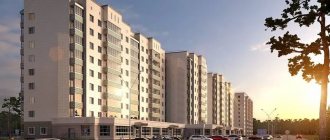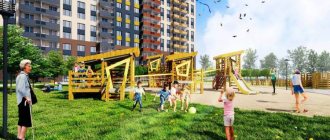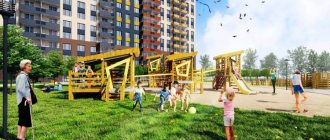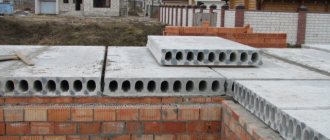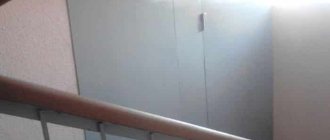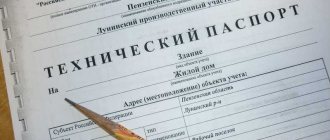This article is part of the series of publications “Myths of Housing and Communal Services”, dedicated to debunking false theories of the housing sector. Myths and false theories, widespread in the housing and communal services sector of Russia, contribute to the growth of social tension, the development of the “Concept of Enmity” between consumers and providers of utility services and residential maintenance services, which leads to extremely negative consequences in the housing industry. The articles in the series are recommended primarily for consumers of housing and communal services, however, specialists in housing and communal services may also find something useful in them. In addition, distributing publications in the “Housing and Communal Services Myths” series among housing and communal services consumers can contribute to a deeper understanding of the housing and communal services sector by residents of apartment buildings, which leads to the development of constructive interaction between consumers and service providers. The full list of articles in the series “Myths of Housing and Public Utilities” is available at the link >>>
**************************************************
The myth discussed in this publication is directly related to previously debunked myths that supposedly common property in an apartment building does not belong to the owners of the premises in such a building. One of the arguments for the refusal of apartment owners to renounce the right of ownership of common property is the reference to the fact that there is a certain owner of an apartment building, who owns all the property in such a building (including common property), with the exception of those premises that have been privatized, purchased or otherwise acquired into the private property of any persons. Supporters of the false theory most often name the state or municipal entity on whose territory the apartment building is located as the owner of an apartment building. In this article we will analyze this position.
The essence of the false theory
Supporters of the false theory believe that since in the USSR all buildings, including apartment buildings (hereinafter referred to as apartment buildings), belonged to the state, when apartments were transferred into private ownership during privatization, the owner of the apartment buildings themselves did not change, and it is still the state. The maximum that false theorists are willing to admit regarding the change of owner of an apartment building is the transfer of such a house from the balance of the state to the balance of the municipality.
Thus, in a building owned either by the state or a municipality, there are separate premises that are owned by individuals or legal entities. Accordingly, everything that is not within the boundaries of private property (not located within the apartments), including common property, belongs either to the state or to the municipality.
False theorists even present some extracts from the Unified State Register of Real Estate, which supposedly confirm the ownership of a municipality or state in an apartment building.
In this article, we will try to figure out whether an apartment building has an owner and what kind of extracts from the Unified State Register are presented by supporters of the false theory to confirm ownership of the apartment building.
Is MKD an object of law?
The first thing you should pay attention to is the very definition of the term “apartment building”.
In accordance with paragraph 6 of the Regulations on recognizing premises as residential premises, residential premises unsuitable for habitation, an apartment building in disrepair and subject to demolition or reconstruction, a garden house as a residential building and a residential building as a garden house, approved. RF GD dated January 28, 2006 No. 47: “6. An apartment building is a set of two or more apartments that have independent access either to a land plot adjacent to a residential building or to common areas in such a building. An apartment building contains elements of the common property of the owners of premises in such a building in accordance with housing legislation .”
Already from the above definition it follows that an apartment building is a collection of several real estate objects. Such objects include premises in an apartment building, as well as those elements of common property that are premises and a land plot (that is, real estate objects). In this article we will not analyze in detail who owns the common property, since this issue has been repeatedly discussed in articles on the AKATO website (for example, in the publications “ Who owns the common property? ”, “ Who owns and manages the common property? ”).
It is important to note that apart from the premises and elements of common property, there is nothing else in the apartment building. That is, it is the totality of premises and common property that form an apartment building, and this list is exhaustive. The position that in an apartment building there may be premises belonging to individual owners, common property that is in shared ownership of the owners of the premises, and anything else, is not based on the law - there is no “anything else” in an apartment building.
Thus, MKD is a collection of objects belonging to different owners.
Can a situation exist in which several things owned by different persons will collectively belong to some other person? For example, if two cars belong to two different owners, can they be jointly owned by a third owner?
Of course, a different example with a car can be given. For example, two cars belonging to two different owners use a garage belonging to another, third owner. What is not an example of MKD? But here we need to analyze the reasons for using such a garage. After all, it is obvious that car owners using someone else’s garage will have to somehow pay for such use. And the procedure and amount of such a fee will not be determined at a general meeting of car owners using the garage.
But there are garage cooperatives, there are garages, the use of which is determined by the car owners? And in what cases does this happen? And this happens when these very garages belong to these very car owners, and if we are talking about a garage cooperative, then the decisions are made by those car owners who are members of these cooperatives, that is, the founders, owners of such cooperatives.
The same logic is present in matters of managing common property in apartment buildings - the owners of this property manage this property. And the owners of common property in an apartment building are the owners of the premises in such an apartment building.
Owners of premises in apartment buildings own their premises individually and the common property jointly. That is, as objects of law in MKD there are separate premises (including apartments), as well as the common property of the owners of the premises. Taken together, several objects of law do not form a new object of law. Thus, technically there is such an object as an “apartment building”, but apartment building as an object of law does not exist.
Consequently, it is impossible to determine the owner of an apartment building as a whole, since when determining persons who have ownership rights to individual elements of an apartment building, it is possible to determine only the owners of individual premises in the house, who collectively own the common property in such a house.
How to understand what constitutes the common property of an apartment building according to clause 3, part 1. Art. 36 Residential Complex of the Russian Federation
How to understand what constitutes the common property of an apartment building according to clause 3, part 1. Art. 36 Residential Complex of the Russian Federation
1. Article 36 of the Housing Code of the Russian Federation speaks, judging by its name, about the right of ownership of the common property of the owners of premises in an apartment building (hereinafter referred to as the house) and in particular in paragraph 3 of part 1 of this article it is written: - “ 1. Owners of premises in an apartment building The common property in an apartment building belongs by right of common shared ownership, namely:
3) roofs enclosing load-bearing and non-load-bearing structures of a given house, mechanical, electrical, sanitary and other equipment (including structures and (or) other equipment designed to ensure unhindered access for people with disabilities to premises in an apartment building) located in this house outside or inside the premises and serving more than one room;”[1]
2. Clause 3, Part 1, Art. 36 of the Housing Code of the Russian Federation lists the types of common property. This listing is separated by commas and the conjunction “and”. But even with this selection of enumerations, this enumeration can be read and understood in different ways.
3. For the correct understanding declared in this article, you need to know what the legislator wanted to say when he wrote this norm as he stated it. This is required to correctly interpret and apply this article.
4. Let’s start with the phrase: “roofs enclosing the load-bearing and non-load-bearing structures of a given house...”
5. Here, does everything that is further listed in the above quote refer to the word “roof” or not?
6. Let’s ask ourselves a question: do the roofs protect the load-bearing and non-load-bearing structures of a given house? Fenced. This means this is the first understanding and it relates only to the concept of a roof, as an object of common property rights.
7. Is there a second meaning? I suppose it exists. I believe that no one doubts that the “roof” is an independent object of ownership? But the second similar object in the right of ownership will most likely be “the enclosing load-bearing and non-load-bearing structures of this house.” After all, a house has walls, which can be load-bearing or non-load-bearing, and which also make up the structure of the house. But should these structures be only enclosing? Protecting from what?
8. So in this case the legislator wanted to point out to us one component in the right of common ownership or two? Is there enumeration here or not?
9. Next, let us turn to the phrase “other equipment (including structures and (or) other equipment designed to ensure unhindered access for people with disabilities to premises in an apartment building), located in a given building outside or inside the premises and serving more than one premises;”
10. First, about what is indicated in brackets. I exclude from the detailed analysis what is indicated in brackets, although there are questions about this part. I will briefly note in this part only that some of the houses will be equipped with a ramp and handrails for their use by citizens with disabilities. The ramp and handrails are clearly outside the house. Most often, they were not even included in the house construction project, and were subsequently made additionally. Should they constitute the common property of the house? I suppose they should. But how to register ownership of this ramp and handrails? Who should do this? Do you need a decision from the general meeting of owners of the premises for this? Or is it enough to contact Rosreestr, for example, a management company with an application for state registration of rights? Is it even necessary to apply to Rosreestr to register such a right? Maybe contacting the Bureau of Technical Inventory (BTI) is enough? Should a project be developed for this ramp and handrails? Where should this project be stored? Should this project be submitted to Rosreestr along with an application for state registration? Or should the project be submitted to the BTI? The answers to other questions depend on the answer to these questions - for example, what is subject to major or routine repairs in this house? How and where can I find out about the composition of the common property of the house?
11. By excluding the text from brackets, we get the following construction of clause 3, part 1, article 36 of the Housing Code of the Russian Federation - “other equipment located in a given house outside or inside the premises and serving more than one room;” Let's try to analyze this.
12. So there is some “other equipment”. It may be in this house. Can it be located outside this house? Since the indication in the text of the article says “outside or inside the premises and serving more than one premises,” I conclude that the common property of the house may be outside the premises of the house, but it must serve more than one premises, since the conjunction “and” is used before the words “serving” more than one room."
13. There may be other interpretations of the text of this article.
14. It would be interesting to know them. Especially in that part - how to properly register the common property that appeared in the house after passing a technical inspection by the BTI authorities and registering ownership? For example, a general meeting in a house decided to install a video surveillance system, connect it to the general house power supply system and delegate to the management company the conclusion of an agreement for the installation of such a system and the choice of the location of video surveillance cameras to monitor the common property of this house. Such video cameras were installed on the front facade of the house. But from them it is not possible to view the general property of the house, but you can only view the green area in front of the house. And let’s say I don’t agree with this arrangement of CCTV cameras. What to do in this case? How can I find out if this video surveillance system has been added to the common property?
15. But all this text, which was difficult to understand, had to be written a little differently, using the division of the paragraph into paragraphs. Let this cause an increase in the volume of the text of the law, but it will be more understandable to those who read and apply it.
[1] “Housing Code of the Russian Federation” dated December 29, 2004 N 188-FZ (as amended on December 30, 2020) https://www.consultant.ru/cons/cgi/online.cgi?rnd=282E96D30C9774B48F8076C446CBB4A7&base=LAW&n=371925&dst =4294967295&cacheid=814E81794B83451DA3E745053F736101&mode=rubr&req=doc#09957780949181851 (accessed February 18, 2021)
What do the documents say?
False theorists love to operate in legal terms. When talking about the owner of an apartment building, supporters of the false theory in question often use accounting terms, declaring that “the apartment building is on the balance sheet of the municipality.”
Let's see if MKD can be an object of accounting.
By order of Rosstandart dated December 12, 2014 No. 2018-st, “OK 013-2014 (SNS 2008) was adopted and put into effect. All-Russian Classifier of Fixed Assets" (hereinafter - OKOF). According to the Introduction of the OKOF, “OKOF is used for the purposes of budgetary (accounting) accounting by public sector organizations in cases provided for by federal standards, unless otherwise established by the authorized bodies of state regulation of accounting. The objects of classification in OKOF are fixed assets.”
OKOF assigns code 100.00.00.00 to the group “Residential buildings and premises”. It is important to note that in this grouping there is no such type of object as “apartment buildings” . That is, in principle, there is no such object of law as an “apartment building”; an apartment building cannot be on anyone’s balance sheet, cannot be an object of accounting.
An apartment building exists as a technical object. However, such an object of law as an “apartment building” does not exist.
But what about the extracts from the Unified State Register of Real Estate, where it is written in black and white that the owner of the apartment building is supposedly the municipality?
Let's consider one of these extracts presented by false theorists (shown in the figure). If you look at the information about the copyright holder in Section 2, then such information actually contains an indication that the municipal entity has the right of ownership (circled in red in the figure). But if you look at the list of real estate objects to which the municipality has the right (circled in blue in the figure), you can see that individual premises of the house are listed as such objects. Moreover, if you look closely at the numbers of these premises, you can see that these are not all premises - some of the numbers are missing, since the premises with the missing numbers are owned not by the municipality, but by other owners.
Thus, the presented Extract contains information about ownership only of individual premises in the apartment building, and not of the entire apartment building as a whole. Information on the ownership of any apartment building in the Unified State Register cannot be contained, and, consequently, no Extracts from the Unified State Register allegedly confirming the ownership of any public entity (or anyone at all) to the apartment building as a whole, simply does not exist. Because there is simply no such object of law as MKD.
And even if all the premises in the apartment building have one owner, this owner will own precisely these premises, and the Extract from the Unified State Register in this case will contain information about all the premises in the house. As the owner of all premises in the house, such a person will solely own the common property in the apartment building. But in no case will such a person be considered the owner of the apartment building as a whole.
Additionally, it is worth noting that Part 5 of Article 40 of the Federal Law of July 13, 2015 N218-FZ “On State Registration of Real Estate” directly establishes: “When state registration of ownership of an apartment or non-residential premises in an apartment building, state registration of a share in the common right is carried out simultaneously ownership of the premises and land plot constituting the common property therein. State registration of ownership of an apartment building is not carried out .”
CALCULATION OF FEE for content maintenance. Unusual (as required by law)
FEE for the maintenance of COMMON PROPERTY.
How to calculate it?
1. Regulatory framework
By virtue of Part 1 of Art. 35 of the Constitution of the Russian Federation, the right to private property is protected by law. Part 2 Art. 35 of the Constitution of the Russian Federation establishes that everyone has the right to own property, own, use and dispose of it, both individually and jointly with other persons.
Article 249 of the Civil Code of the Russian Federation reproduces this principle, establishing that each participant in shared ownership is obliged, in proportion to his share, to participate in the payment of taxes, fees and other payments on common property, as well as in the costs of its maintenance and preservation. This general rule is enshrined in paragraph 1 of Art. 158 of the Housing Code of the Russian Federation, according to which the owner of premises in an apartment building is obliged to participate in the costs of maintaining common property in an apartment building in proportion to his share in the right of common ownership of this property by paying a fee.
According to Art. 39 of the Housing Code of the Russian Federation, the owner of the residential premises bears the burden of maintaining the common property in the part and his share in the right to the common property of the apartment building. The share of mandatory expenses for the maintenance of common property in an apartment building, the burden of which is borne by the owner of the premises in such a house, is determined by the share in the right of common ownership of the common property in such a house of the specified owner. The share in the right of common ownership of common property in an apartment building of the owner of the premises in this house is proportional to the size of the total area of the specified premises by virtue of clause 1 of Art. 37 Housing Code of the Russian Federation.
2. Calculation method
To correctly calculate the share in the right to the common property of an apartment building of the owner (residential or non-residential) premises in this building, it is necessary to establish: 1) the total area of the apartment building; 2) the total area of premises owned by the owners; 3) the total area of the premises belonging to a specific owner.
In the absence of a decision by the owners on a different determination of the share in the right to common property in an apartment building, one should be guided by the general rule according to which, in order to determine the share in the right to common property in an apartment building, the proportion should be calculated according to the rule of paragraph 1 of Article 37 of the Housing Code of the Russian Federation.
The Constitutional Court of Russia drew attention to this in paragraph 3 of its Resolution No. 5-P dated January 29, 2018, as well as the Supreme Court of Russia in its Decision No. 305-ES18-13931 dated September 25, 2018, according to which the amount of payment for the maintenance and repair of common property determined by the share in the right of common ownership of common property, which is proportional and not equal to the size of the apartment area.
Thus, when calculating fees for housing services, the tariff established in rubles per square meter should be multiplied not by the area of the premises in the property, but by another area - by the area of the payer's share in the common property, determined by multiplying the share (a dimensionless value, which is always less units) per area of common property.
3. Calculation example
Following the law, we come to the conclusion that the tariff factors must be two quantities: the share in the right and the area of the common property.
Let's take a typical five-story apartment building. Let the area of the property be 3000 square meters, the number of apartments will be 60, the area of each apartment will be 50 square meters (total 60 X 50 = 3000). We will take the area of the common premises of the apartment building to be 450 square meters. Let the housing maintenance tariff be 20 rubles per square meter.
Then the share in the common property: 50/3000 = 1/60. Multiplying the share by the area of common property (450) and the tariff (20), we get:
20 rub./sq.m x 1/60 x 450 sq.m = 150 rub.
For comparison, we will show the result of scammers using the area of an apartment (50 sq m) as a tariff factor:
20 rub./sq.m x 50 sq.m = 1000 rub.
conclusions
This article proves that there is no “owner of an apartment building.” MKD is a set of premises owned by individual owners and common property that is in shared ownership of the owners of the premises, and is not a separate object of law.
An apartment building cannot be on anyone's balance sheet.
Ownership of MKD cannot be registered in the Unified State Register of Real Estate.
Only the right to individual premises in an apartment building is subject to state registration, and the same registration of ownership of the premises is at the same time state registration of ownership of a share in the common property (Part 5 of Article 40, Part 1 of Article 42 of the Federal Law of July 13, 2015 N218-FZ " On state registration of real estate").
The opinion about the possibility of ownership of the entire apartment building belonging to any individual owner is incorrect and is not based on the law.
Author: Nifontov D.Yu.
housing and communal services myths 29 mkd 66oi 21
Did you like the article?
Subscribe to stay updated on current articles and the most important housing and communal services news.
